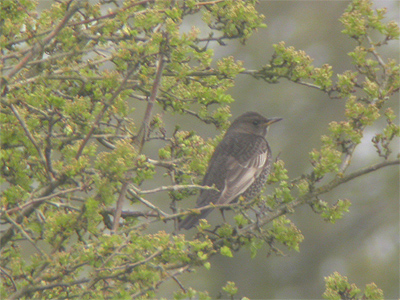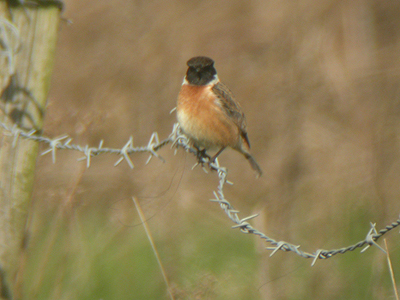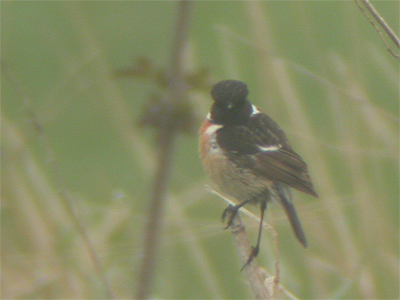| Spring summary It will not be remembered for it's
number of migrants, but Spring 2008 must go down as one
of the most varied in 11 years recording here. In year
listing terms, this has to be one of the best, producing
an assortment of rare and scarce migrants. But once
again, visible migration was extremely poor, with very
few notable totals.
The number of Wintering
thrushes remained very low and there were to be none of
the typical build-ups of large numbers of Fieldfare. The
best Fieldfare count, turned out to be 53 moving
north-east on March 24th.
Otherwise, all other species
produced only meagre totals although 124 Starling east on
26th was more notable. The only exception was Meadow
Pipit, which produced their best Spring count since 2001
when 244 flew north-west on March 27th.
|
|
 |
| .... |
| Although much
of the sky was completely devoid of any notable visible
migration for much of the time, there were still some
occasional highlights. An unexpected record concerned two
Hawfinch that flew north towards Lound
Wood on April 6th, which was the first since August 1999
and only the second ever Hawfinch record. Three
Tree Pipit in a Spring here is unheard of, so it
was pleasing that singles were noted on three April dates
(17th, 19th and 23rd) whilst three Common
Crossbill flew north over Eakring Flash on the
afternoon of March 26th. Another rarity of recent years has been Corn
Bunting, so it was especially pleasing when one
flew east over Eakring Flash (the first for five years)
on a very productive April 27th morning - a morning which
also produced the only Whinchat of the
Spring. The first Wheatear of the
Spring, was a male briefly at Eakring Field Farm on March
30th and there were additional April records involving
single males at Park Farm (2nd) Tug Bridge Farm (14th)
and in fields at Kersall (17th) Four Wheatears arrived at
two sites on 10th, with three males in fields at Park
Farm and a female at Red Hill. Male Redstarts
were at Eakring Flash on April 10th and 27th. A group of
12 Fieldfare at Penny Pasture Common also held a female
Ring Ouzel which remained from April 19-23rd.
This bird could be very difficult to locate at times,
spending much of it's time feeding on Ivy berries
(something at least two other Ring Ouzels have done here
in the past) but did show quite well occasionally on a
few mornings.
A new species for the area
came when a Nightjar flew over Lound
Wood and headed south-west at 23:15h on May 20th.
Raptor migration
Perhaps the bird of the
period was the Hen Harrier seen
quartering fields in the Red Hill area for around five
minutes, before eventually drifting west and out of view
on April 27th. This was almost certainly the bird which
had been recorded at Bolsover, then Carburton, before
being seen at Eakring and then a day or so later was seen
flying over Mansfield Woodhouse. Hen Harrier continues to
be one of the rarest raptors here with only four records
since 1999, but now seen twice in the last two years.
April had opened with a Red
Kite west over Lound Wood on 1st. Red Kite has
now become virtually annual at Eakring and looks set to
become even more common in the years ahead.
Unfortunately, there was to be no Osprey (last Spring
record here in 2005) or Marsh Harrier (2002) even though
both have shown similar fortunes as the Red Kite. Migrant
Common Buzzards were noted on three Spring dates, with
five (all singles) coming over from the south-west and
continuing north and north-east on March 14th, with the
end of April also seeing some passage with a group of
seven Common Buzzards high south-east (27th) followed a
few days later by three more high south-east on 29th.
There were records of four different Peregrines
between February and April, whilst a Merlin moving west
over Eakring Flash and Red Hill on March 29th, maintained
the regularity of records in recent years. There were no
records of Hobby.
|
| .... |
| Record Stonechat
passage The
one notable ornithological feature of the Spring was
(without doubt) the record number of Stonechats which
moved through the area during late February and most of
March. Stonechats had been noted arriving at some
south-coast sites during the last week of February, but
it was still a great surprise when three birds turned up
at Eakring on the 28th, with a male along the roadside
between Eakring and Wellow and a pair along the boundary
fence at Penny Pasture Common. These were the first
February records here since 2001.
A further 16 Stonechats
continued to appear throughout the whole of March, so
when you consider that there had never been any more than
three Stonechat in a single Spring here before, then the
scale of this passage needs little imagination.
|
|
 |
| .... |
| Upper
photograph: One of the many hibernans
Stonechats (upper right) which moved through the area in
late February and throughout most of March. |
| Lower
photograph: Continental Stonechat (rubicola)
which was at Eakring Flash on April 23rd. |
| .... |
| Penny Pasture Common
provided eight of the month's Stonechat with five (four
males and a female) present on March 4th, followed by
another male on the 6th and then a male and female on the
19th. Two males were along roadside hedges near Eakring
Field Farm on 29th, whilst roadside hedgerows near
Wellow, also produced a female on the 14th and a male on
the 17th. Records from Eakring Flash included two males
(14th) and females on both 15th and 29th. However, the most interesting
Stonechat did'nt turn up until the extremely late date of
April 23rd and was almost certainly of the continental
race rubicola. It was present at Eakring Flash
from early morning and remained until dusk, initially
favouring a grass track and rough vegetation near Eakring
Flash, but then relocated to the north-eastern corner of
Eakring Flash, where it remained for the rest of the day.
|
|
 |
| .... |
| Stonechat had
never before produced an April record here, with late
Winter and early Spring records all falling between
inclusive dates of February 21-March 29th. The occurrence
of this bird came over three weeks later than all
previous records. Migrant
arrival dates
There were no records of
Cuckoo or (as mentioned earlier) Hobby this Spring.
Spotted Flycatchers were not recorded moving through the
area, but a pair was discovered feeding young at Eakring
during June, having presumably arrived at the end of May.
Redstart and Tree Pipit
were the only two species to produce new earliest arrival
dates, with both beating their previous earliest dates by
a day. March arrivals included Sand Martin over Hare Hill
Wood and two Chiffchaffs in Eakring village on 27th.
April arrivals included Swallow 4th, Blackcap 7th, Willow
Warbler 10th, Yellow Wagtail 17th, Grasshopper Warbler,
Whitethroat, House Martin and Turtle Dove 21st, Lesser
Whitethroat 22nd, Sedge Warbler 24th, Swift 27th and
Garden Warbler 30th.
January- June 2008
monthly migration totals
|

